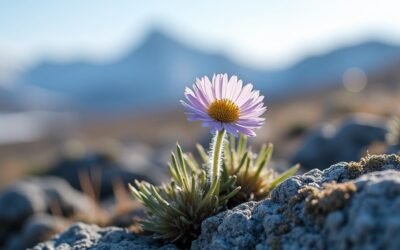The Arctic lousewort (Pedicularis arctica) is a hardy flowering plant that's perfectly adapted to life in the harsh circumpolar regions. It grows 5-30 cm tall, featuring deep pink to purple flowers arranged in terminal spikes and distinctive fern-like foliage. The plant's remarkable adaptations include specialized root systems that extend 15-20 cm into frozen soil and cellular mechanisms that allow survival in temperatures below -40°C. It thrives in rocky tundra slopes and alpine meadows between sea level and 3,000 meters elevation, completing its entire life cycle during the brief Arctic summer. This resilient species holds fascinating secrets about survival in Earth's most challenging environments.
INTRODUCTION
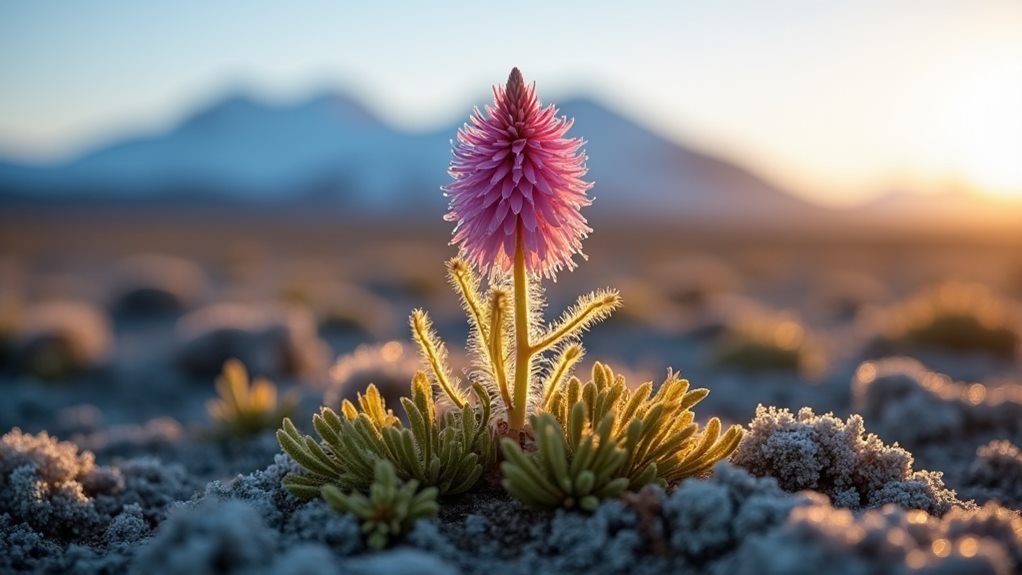
The Arctic Lousewort (Pedicularis arcticus) belongs to the diverse family Orobanchaceae, which encompasses numerous parasitic and semi-parasitic flowering plants.
This hardy perennial, found throughout the circumpolar regions of the Northern Hemisphere, carries several regional common names including Arctic Lousewort, Northern Lousewort, and Arctic Wood-betony.
Though its scientific classification has undergone revisions over time, botanists consistently recognize it as a member of the genus Pedicularis, which includes approximately 500 species distributed primarily across Arctic and alpine environments.
Common Name(s)
Arctic lousewort's most common English names include wooly lousewort, Sudetic lousewort, and Langsdorff's lousewort. These names reflect the plant's distinctive appearance and historical significance in folk medicine across northern regions. The term "lousewort" itself originates from the medieval belief that livestock grazing on these plants would develop lice infestations, though this connection has been thoroughly disproven by modern science.
In various indigenous cultures, particularly among Arctic and sub-Arctic communities, the plant carries names that often translate to "healing flower" or "mountain healer," reflecting its traditional medicinal uses. Native healers have historically employed Arctic lousewort's leaves and flowers to treat respiratory conditions and minor wounds, though scientific validation of these applications remains limited.
The plant's scientific name, Pedicularis arctica, combines the Latin word "pedicularis," meaning "relating to lice," with "arctica," denoting its polar habitat. While some regions use localized common names that reference the plant's distinctive pink-purple flowers or its growth pattern in tundra environments, the Arctic lousewort designation remains the most widely recognized identifier in scientific literature and field guides.
Scientific Name
Pinpointing the exact scientific classification of Arctic lousewort requires understanding its taxonomic placement within the genus Pedicularis. The plant's scientific name, Pedicularis arctica R. Br., was first established by botanist Robert Brown in 1823, reflecting its Arctic habitat and distinctive characteristics.
Within the family Orobanchaceae, Arctic lousewort demonstrates remarkable genetic diversity across its circumpolar distribution. The species exhibits notable evolutionary adaptations that have allowed it to thrive in harsh polar environments, where temperatures frequently drop below -40°C.
Its taxonomic relationship to other Pedicularis species reveals a fascinating pattern of adaptive radiation in Arctic regions. Modern molecular studies have confirmed the plant's placement within the broader Pedicularis genus, which includes approximately 600 species worldwide.
The specific epithet "arctica" directly references its geographic distribution and environmental preferences, while recent genetic analysis has revealed distinct regional variations among populations. These variations suggest ongoing evolutionary processes as the species continues to adapt to changing Arctic conditions, making it an important subject for researchers studying climate-driven speciation events.
Family Classification
Building on its scientific nomenclature, Arctic lousewort belongs to Orobanchaceae, a family of parasitic and hemiparasitic flowering plants. This diverse family, formerly classified under Scrophulariaceae, comprises approximately 2,000 species distributed across 90 genera worldwide, with Pedicularis being one of its largest genera.
Recent phylogenetic analysis has revealed fascinating evolutionary relationships within Orobanchaceae, positioning Arctic lousewort among other specialized root parasites that have developed sophisticated mechanisms for obtaining nutrients from host plants.
The family's defining characteristic is its members' ability to form specialized organs called haustoria, which penetrate host plant roots to extract essential resources. Through extensive molecular studies, researchers have established that Arctic lousewort shares key genetic markers with other Orobanchaceae species, confirming its placement within this remarkable plant family.
The shift from fully autotrophic ancestors to the current parasitic lifestyle represents one of botany's most intriguing evolutionary adaptations, with Arctic lousewort exemplifying the family's successful exploitation of this ecological niche.
This classification has significant implications for understanding the species' biology, conservation needs, and potential interactions with other Arctic flora.
QUICK IDENTIFICATION GUIDE
The Arctic Lousewort's distinctive features make it readily identifiable in its native tundra habitat.
Growing to a compact height of 5-15 cm, this diminutive plant displays deep pink to purple flowers arranged in dense terminal spikes above finely divided, fern-like foliage.
The plant develops a sturdy taproot system that anchors it against harsh Arctic winds, while its wooly stems and leaves showcase a silvery-green coloration that serves as a protective adaptation to extreme conditions.
Height/Spread
Measuring between 5-30 cm in height, Arctic lousewort remains a relatively compact perennial herb that spreads modestly through its underground rhizomes. The plant's growth patterns demonstrate remarkable adaptation to harsh Arctic conditions, with individual specimens rarely exceeding the maximum height range even in ideal growing conditions.
In terms of plant dimensions, Arctic lousewort typically forms small clusters that spread laterally across 10-15 cm, creating dense but contained colonies in their native tundra habitats. The plant's modest spread reflects an efficient survival strategy, allowing it to establish stable root systems while minimizing exposure to fierce Arctic winds.
Each stem grows upright like a diminutive sentinel, maintaining its compact form through precise resource allocation from the rhizome network below.
The compact nature of Arctic lousewort serves multiple purposes, from heat conservation to wind resistance, making it a master of spatial efficiency in the tundra ecosystem.
Despite its small stature, the plant maximizes its growing space by developing a dense, almost architectural arrangement of leaves and flowering stems within its limited footprint.
Physical Characteristics
At first glance, Arctic lousewort can be identified by its distinctive pink-purple flowers that grow in dense terminal spikes and fern-like leaves arranged in a basal rosette. The plant's morphology reflects its remarkable adaptations to harsh Arctic conditions, featuring deeply divided leaves that help reduce wind resistance and moisture loss.
Each flower measures approximately 15-20 millimeters in length, displaying bilateral symmetry with two lips: an upper hooded structure and a broader lower lip. The plant's stems, typically reaching 5-15 centimeters tall, are often tinged with a reddish hue that helps absorb heat in the cold environment.
Its ecological adaptations include a robust root system that penetrates deep into the permafrost, allowing the plant to access nutrients and water in nutrient-poor soils.
The leaves exhibit a pinnately compound structure, resembling miniature fern fronds, with each leaflet further divided into small, toothed segments. During the growing season, the foliage maintains a vibrant green color, while developing a bronzed appearance as temperatures drop, signaling the plant's preparation for winter dormancy.
Root System
Root structures of Arctic lousewort consist of a taproot system that typically extends 15-20 centimeters into frozen soil layers. The root morphology reveals remarkable adaptations for surviving in permafrost conditions, with specialized lateral roots branching horizontally at depths of 5-8 centimeters.
These hardy roots employ an intricate network of fine root hairs that maximize nutrient acquisition in nutrient-poor Arctic soils. Like tiny underground miners, the root system extracts essential minerals and water from the brief window when the soil thaws.
The plant's root structure has evolved specialized cells that can withstand repeated freeze-thaw cycles, protecting crucial tissue from rupturing during temperature fluctuations.
Most fascinating is the root's relationship with soil microorganisms, which enhance nutrient uptake through symbiotic partnerships. The taproot's central core maintains a diameter of 3-4 millimeters, while secondary roots taper to mere fractions of a millimeter.
This efficient design allows the Arctic lousewort to anchor itself firmly while maximizing its surface area for absorption, demonstrating nature's elegant solution to the challenges of Arctic survival.
Visual Identifying Features
The Arctic lousewort stands out from among other tundra plants with its distinctive pink-purple flowers and deeply divided, fern-like leaves. Rising to heights between 5-20 centimeters, this compact perennial displays its blooms in dense, terminal spikes during the brief Arctic summer.
The plant's adaptation strategies are evident in its visual cues, featuring leaves that are pinnately divided into small, toothed segments, creating a delicate, feather-like appearance. Its flowers, measuring 15-20 millimeters in length, possess a distinctive hooded upper lip and a broader lower lip, resembling miniature elephant heads when viewed from the side.
The calyx, a protective structure surrounding the flower base, exhibits a woolly texture with fine, white hairs that help maintain warmth.
During its flowering period from late June to early August, the plant's stems take on a reddish-purple hue, while the foliage maintains a deep green color. The overall growth pattern is typically clustered, with multiple stems emerging from a single rootstock, creating small, dense colonies that serve as visual markers across the tundra landscape.
HABITAT & GROWTH
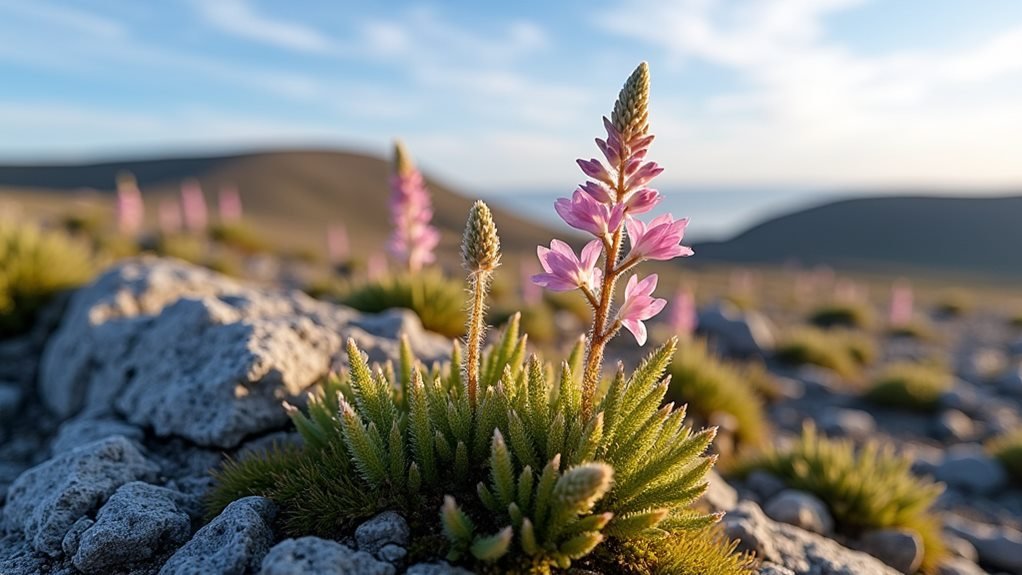
The Arctic Lousewort thrives across the circumpolar regions of North America, Europe, and Asia, where it's adapted to survive in harsh tundra conditions.
During its brief growing season from June through August, this hardy perennial emerges through snow-packed soil to reach heights of 5-15 centimeters.
The plant shows a marked preference for well-drained, acidic soils in alpine meadows and rocky slopes, where it can establish robust colonies in areas with pH levels between 4.5 and 6.0.
Natural Distribution
Found across the Arctic tundra, Pedicularis sudetica (Arctic lousewort) thrives in moist, cold environments between sea level and 3,000 meters elevation. The plant's distribution stretches across circumpolar regions, including northern Canada, Greenland, Russia, and Scandinavia, where it's adapted to harsh environmental conditions.
This hardy species shows remarkable resilience to extreme temperatures, but climate impact threatens its traditional range as warming temperatures alter the delicate Arctic ecosystem. In North America, it's particularly abundant throughout Alaska and the Canadian territories, forming substantial populations in well-drained tundra soils.
The plant's distribution patterns often align with permafrost regions, where seasonal melting creates the moisture-rich conditions it prefers. Recent studies indicate that habitat loss due to industrial development and changing precipitation patterns has begun to fragment some populations, especially at lower elevations.
Despite these challenges, Arctic lousewort maintains stable communities in remote, undisturbed areas above the Arctic Circle, where human activity remains minimal. Its ability to colonize newly exposed soils following glacial retreat demonstrates the species' capacity for adaptation within its geographic range.
Growing Season
Arctic lousewort's natural range directly influences its distinct growing season, which spans the brief Arctic summer. The plant typically emerges from dormancy in late May or early June, when soil temperatures consistently reach above freezing and snowmelt provides essential moisture.
During its compressed growing season, Arctic lousewort demonstrates remarkable growing techniques that maximize its limited time. The plant rapidly develops its characteristic pink-purple flowers within 4-6 weeks of emergence, taking advantage of the extended daylight hours during the polar summer.
Like an efficient solar panel, it harnesses the constant illumination to accelerate photosynthesis and nutrient absorption.
Seasonal variations greatly impact the plant's development cycle, with flowering periods shifting by up to two weeks depending on latitude and local climate conditions. In areas where permafrost thaws later, the growing season may be reduced to just 6-8 weeks.
The plant completes its entire reproductive cycle, including seed production and dispersal, before September's falling temperatures trigger dormancy. This precisely timed schedule guarantees the species' survival in one of Earth's most challenging environments.
Growing Conditions
Natural habitats of this hardy plant include rocky tundra slopes, alpine meadows, and well-drained gravelly soils across the circumpolar region. Arctic Lousewort has adapted remarkably well to these challenging environments, thriving in areas where many other plants struggle to survive.
The plant's soil requirements are quite specific, preferring well-drained substrates with a pH ranging from slightly acidic to neutral (6.0-7.0). While it can tolerate poor soil conditions, the substrate must provide adequate drainage to prevent root rot during the brief summer thaw.
Moisture levels play a vital role in the plant's success, as it requires moderate moisture during its growing season but can withstand periods of drought once established.
Arctic Lousewort has developed specialized root structures that help it anchor firmly in loose, rocky soils while efficiently absorbing limited nutrients and water. These adaptations allow it to flourish in areas with strong winds and temperature fluctuations typical of arctic and alpine environments.
The plant's compact growth habit and deep-reaching roots act as natural defenses against the harsh conditions of its extreme habitat.
ARCTIC ADAPTATIONS
The Arctic Lousewort displays remarkable adaptations that allow it to withstand temperatures well below -40°C through specialized cellular membranes and antifreeze proteins.
During the Arctic's endless summer days, the plant synchronizes its growth and flowering cycles with the 24-hour daylight, maximizing photosynthesis during the brief growing season.
Its extensive root system penetrates the active layer of permafrost, anchoring firmly while accessing water and nutrients from soil that remains frozen most of the year.
Cold Tolerance Mechanisms
Throughout millions of years of evolution, Arctic lousewort has developed remarkable cold tolerance mechanisms to survive in harsh polar environments. The plant undergoes extensive cold acclimation during autumn months, gradually modifying its cellular structure to withstand temperatures as low as -40°C.
The plant's frost resistance relies on sophisticated biochemical adaptations, including the production of specialized antifreeze proteins and osmolytes that prevent ice crystal formation within cells. These compounds work like natural antifreeze, lowering the freezing point of cellular fluids and protecting essential organelles from damage. The lousewort's leaves contain up to 30% higher concentrations of these protective molecules compared to temperate plants.
During extreme cold snaps, Arctic lousewort can rapidly trigger the expression of cold-responsive genes, which activate within hours of temperature drops. These genes initiate the production of membrane-stabilizing lipids and stress proteins that act as molecular chaperones, preventing cellular components from degrading.
The plant's roots also develop increased concentrations of soluble sugars, which serve as both cryoprotectants and energy reserves during prolonged freezing periods.
Light Response (24-hour cycles)
Arctic lousewort's unique circadian rhythm allows it to thrive under extreme polar light conditions, where summer brings constant daylight and winter plunges into total darkness. The plant's remarkable photoperiod sensitivity enables it to maximize photosynthetic efficiency during the brief growing season, when light intensity remains consistently high for weeks.
During the midnight sun period, this hardy perennial adapts its metabolic processes to capitalize on the extended daylight, producing specialized proteins that help regulate its growth patterns. The plant's light-harvesting mechanisms can fine-tune their response to varying light intensities, much like a photographer adjusting camera settings for different exposures.
When light levels fluctuate, even slightly, the lousewort's leaves reposition themselves to optimize solar energy capture.
As autumn approaches and daylight diminishes, the plant initiates a carefully orchestrated shutdown sequence. This process involves reducing chlorophyll production and redirecting resources to underground storage organs, ensuring survival through the polar night.
The lousewort's sophisticated light response system represents one of the Arctic's most efficient adaptations to extreme photoperiod variations.
Permafrost Survival Strategies
Anchored in permanently frozen soil, Arctic lousewort has evolved specialized root structures that let it survive in permafrost conditions. These adaptations include a shallow but extensive root network that spreads horizontally rather than vertically, maximizing nutrient absorption from the thin active layer of soil.
The plant's remarkable permafrost resilience stems from its ability to rapidly respond to brief periods of soil thaw during the growing season. Its roots can quickly mobilize and absorb nutrients when temperatures rise just above freezing, while specialized proteins protect cellular structures from ice crystal damage during refreezing cycles.
Under extreme conditions, Arctic lousewort employs a suite of biochemical adaptations that function like natural antifreeze compounds. These molecules help maintain cellular integrity when temperatures plummet to -40°C or lower.
The plant's roots also form beneficial partnerships with cold-adapted soil fungi, creating an intricate underground network that enhances nutrient acquisition and stress tolerance. This symbiotic relationship allows the lousewort to thrive in areas where the permafrost extends several hundred meters below the surface, making it a true specialist of the Arctic's harshest environments.
REPRODUCTION
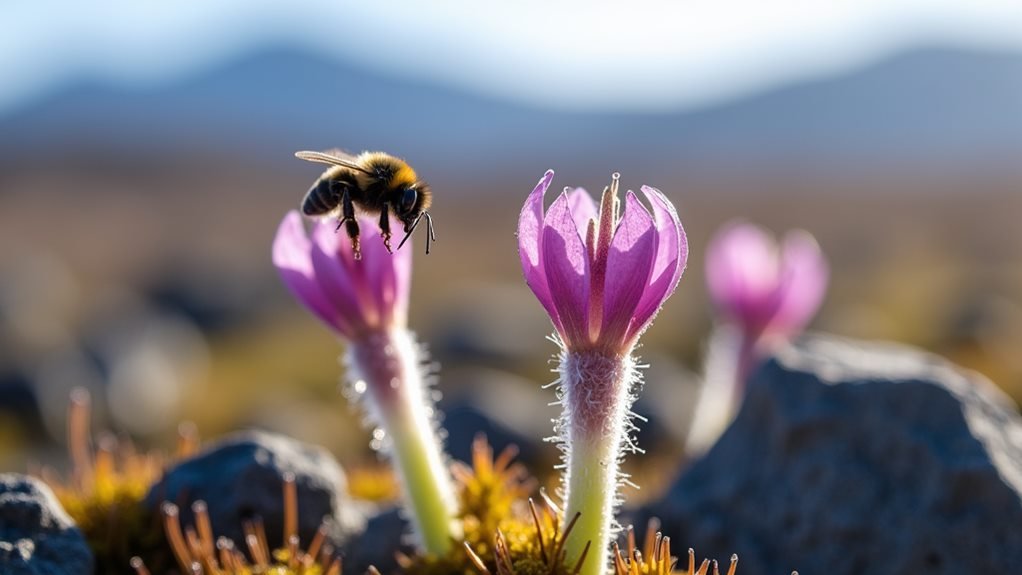
The Arctic Lousewort's reproductive cycle begins with a vibrant flowering period during the brief Arctic summer, typically lasting just 4-6 weeks.
Pollination relies heavily on bumblebees and other hardy insects that can withstand harsh conditions, as these pollinators navigate between the plant's distinctive pink-purple blossoms to transfer pollen.
The tiny, wind-dispersed seeds develop rapidly after fertilization and must complete their maturation before winter arrives, allowing the species to maintain its presence in the challenging tundra environment through a cycle of dormancy and renewal.
Flowering Period
Blooming occurs during the brief Arctic summer, typically between June and August when temperatures rise above freezing. The Arctic Lousewort responds to several flowering triggers, including day length, soil temperature, and the rapid snowmelt that characterizes the region's short growing season.
These environmental cues work in concert to initiate the plant's reproductive phase. The flowering period spans approximately four to six weeks, during which the plant's distinctive pink-purple blooms emerge in a dense, spike-like cluster.
This concentrated flowering window maximizes the plant's pollination strategies by coinciding with peak insect activity in the Arctic ecosystem. Bumblebees serve as the primary pollinators, moving between flowers during the extended daylight hours of the polar summer.
Each individual flower remains viable for 7-10 days, though the entire inflorescence may continue producing new blooms throughout the season. The plant's ability to maintain flowering despite challenging weather conditions demonstrates its remarkable adaptation to Arctic environments, where reproductive success must be achieved within strict temporal constraints.
Pollination Method
While Arctic Lousewort relies primarily on bumblebees for pollination, it also employs a mixed breeding system that includes both cross-pollination and self-fertilization. The plant's distinctive tubular flowers, measuring 15-20 millimeters in length, have evolved specifically to accommodate bumblebee visitors, particularly Bombus polaris and Bombus hyperboreus species.
The pollinator interactions of Arctic Lousewort reveal fascinating breeding strategies adapted to the harsh Arctic environment. When bumblebees are active during the brief summer months, they transfer pollen between flowers while gathering nectar, promoting genetic diversity through cross-pollination.
However, the plant's ability to self-fertilize serves as a vital backup mechanism during periods of limited pollinator activity. The flower's structure facilitates this process through strategically positioned stamens and pistils that can make contact without external assistance.
This reproductive flexibility guarantees successful seed production even in seasons when pollinator populations are low or weather conditions are unfavorable. The plant's mixed breeding system represents an evolutionary adaptation that balances the benefits of genetic diversity with the need for reproductive assurance in the challenging Arctic ecosystem.
Seed Dispersal
After maturation, Arctic Lousewort seeds disperse through a combination of wind and gravity-assisted mechanisms. The plant's capsules split open during late summer, releasing numerous small, lightweight seeds that can travel considerable distances on air currents across the tundra landscape.
The seeds possess specialized adaptations that enhance their dispersal mechanisms, including papery wings that extend from their surfaces, allowing them to remain airborne longer. These extensions, measuring just 0.2-0.3 millimeters in length, create increased surface area relative to the seed's mass, markedly improving their aerodynamic properties.
Seed viability remains remarkably high during the dispersal period, with studies showing that up to 80% of seeds maintain their germination potential even after being transported several hundred meters from the parent plant.
The timing of seed release coincides with the strongest Arctic winds, typically occurring when the ground begins to freeze and snow starts to accumulate. This strategic timing guarantees that seeds can travel across the frozen tundra surface, ultimately settling in depressions and cracks where snow accumulation provides essential insulation and moisture for spring germination.
Lifecycle Stages
The Arctic Lousewort's reproductive cycle begins in early summer when temperatures consistently rise above freezing. As the tundra soil warms, dormant seeds from previous seasons undergo a complex germination process, requiring specific soil conditions and moisture levels to break dormancy.
The lifecycle stages progress through distinct phases, with seedlings emerging within 14-21 days of germination when conditions are ideal. Young plants develop a specialized root system that connects with host plants, establishing parasitic relationships that will sustain their growth throughout the season.
During the vegetative phase, which lasts 4-6 weeks, the plant produces compound leaves and develops its characteristic woolly stem.
Flowering occurs in mid to late summer, with each plant producing 15-30 pink-purple blossoms arranged in dense spikes. After successful pollination, typically by bumblebees and other Arctic insects, seed development begins.
The plant channels its energy into producing viable seeds, which mature within 3-4 weeks. As autumn approaches, the seeds disperse, and the parent plant begins to senesce, completing its annual cycle.
ECOLOGICAL SIGNIFICANCE
The Arctic lousewort plays an essential role in tundra ecosystems as both a food source and an indicator of environmental health.
Several Arctic species, including caribou, muskoxen, and various insects, rely on the plant's nutritious foliage and nectar throughout their life cycles.
As a hemiparasitic species that forms relationships with neighboring plants, Arctic lousewort helps regulate plant community composition and contributes to the intricate balance of Arctic biodiversity.
Role in Food Web
Playing an essential role in Arctic ecosystems, Arctic lousewort serves as both a food source and a host plant for various species. Within the intricate predator-prey dynamics of the tundra, this semi-parasitic plant sustains several herbivorous insects and small mammals, particularly during the brief Arctic summer.
The plant's contribution to nutrient cycling is particularly significant, as it facilitates the transfer of resources between its host plants and the broader ecosystem. Through its hemiparasitic relationship with neighboring grass species, Arctic lousewort creates complex nutrient pathways that benefit multiple organisms in the food web.
Small rodents, such as voles and lemmings, feed on its nutrient-rich foliage, while various butterfly species rely on it for nectar.
Arctic lousewort's position in the food web extends beyond direct consumption, as it influences soil chemistry through root interactions and decomposition processes. When caribou and other large herbivores graze in areas where lousewort grows, they inadvertently promote its dispersal while simultaneously affecting the plant communities that serve as its hosts, creating a fascinating web of ecological interdependence.
Wildlife Dependencies
Many Arctic wildlife species depend fundamentally on Arctic lousewort for their survival throughout different life stages. The plant's interactions with pollinators, particularly bumblebees and butterflies, represent one of the most significant wildlife dependencies in the tundra ecosystem.
The relationship between Arctic lousewort and its wildlife partners has evolved through complex ecosystem dependencies that span multiple trophic levels. Small Arctic mammals, such as voles and lemmings, rely on the plant's nutritious foliage during the brief summer months, while caribou occasionally browse on its leaves during their seasonal migrations.
Several species of moth larvae have developed specialized adaptations to feed exclusively on Arctic lousewort's stems and leaf tissues. These wildlife interactions create a delicate balance in the Arctic food web, where the plant serves as both a primary producer and a keystone species.
Bird species, including the snow bunting and Arctic warbler, frequently visit lousewort patches not only for the seeds but also to feed on the insects that gather around the plants. This interconnected network of dependencies demonstrates how Arctic lousewort functions as a vital hub for biodiversity in the tundra ecosystem.
Environmental Importance
Significant ecological benefits stem from Arctic lousewort's presence in tundra ecosystems, where it serves as a soil stabilizer and nitrogen fixer through its hemiparasitic nature.
Its extensive root system helps prevent soil erosion in fragile Arctic environments, while its ability to extract nutrients from host plants creates a complex web of botanical interactions.
The plant's contribution to climate resilience becomes evident through its role in maintaining permafrost stability, as its root networks help regulate soil temperature fluctuations within a critical 2-3°C range.
This temperature regulation proves especially crucial during the brief Arctic summer when the ground becomes susceptible to thermal degradation.
The lousewort's presence enhances ecosystem stability by supporting diverse microbial communities in the rhizosphere, which process nutrients at rates up to 30% higher than in areas without the plant.
Additionally, the species acts as a natural indicator of ecosystem health, with its population dynamics reflecting broader environmental changes in the Arctic region.
When lousewort populations flourish, they signal the robust functioning of numerous interconnected ecological processes that sustain tundra biodiversity.
HUMAN CONNECTIONS
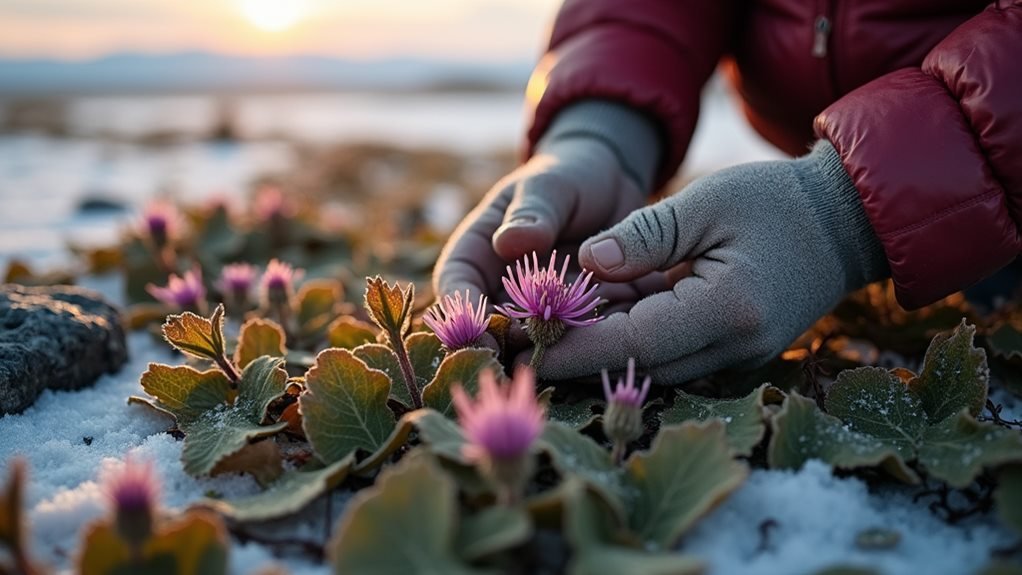
The Arctic lousewort has played a significant role in the traditional practices of northern indigenous peoples, who've used its leaves and flowers in medicinal preparations for generations.
Modern research into the plant's biochemical properties has revealed potential applications in pharmaceutical development, particularly for respiratory conditions and inflammatory responses.
While the Arctic lousewort currently maintains stable populations across most of its range, changing climate patterns and increasing human activities in polar regions have prompted scientists and conservation groups to monitor its status more closely.
Cultural & Traditional Significance
Throughout the ages, indigenous peoples of the Arctic region have relied on Arctic lousewort for both medicinal and ceremonial purposes. The plant's traditional uses have included treating respiratory ailments, reducing inflammation, and serving as a spiritual aid during important tribal ceremonies.
Many Arctic communities have developed deep cultural beliefs surrounding this resilient plant, viewing it as a symbol of endurance and adaptation in the harsh polar environment. The Inuit people, in particular, have incorporated Arctic lousewort into their healing practices for generations, carefully harvesting the plant during specific lunar phases to maximize its therapeutic properties.
The plant's distinctive pink-purple flowers have been woven into traditional stories and folklore, often representing the connection between the physical and spiritual domains. In some communities, Arctic lousewort has been used in coming-of-age ceremonies, where its properties are believed to provide clarity and wisdom to young individuals moving into adulthood.
Today, while modern medicine has largely supplanted traditional remedies, many Arctic communities continue to honor the cultural significance of this remarkable plant through oral histories and traditional knowledge preservation efforts.
Modern Applications
Modern scientific research has validated many traditional uses of Arctic lousewort, sparking renewed interest in its potential applications. Researchers have identified several bioactive compounds in the plant that show promise for medicinal uses, particularly in treating respiratory conditions and inflammatory responses.
The plant's ecological benefits have gained attention in climate resilience studies, as its ability to thrive in harsh Arctic conditions offers insights into plant adaptation mechanisms. Scientists are studying Arctic lousewort's root system and its parasitic relationship with other plants to understand sustainable ecosystem management in tundra environments.
Conservation efforts now focus on developing sustainable harvesting protocols that balance traditional remedies with preservation needs. Several pharmaceutical companies have partnered with indigenous communities to explore the plant's commercial potential while ensuring responsible collection practices.
The plant's compounds are being tested for their antimicrobial properties, while its adaptive strategies provide valuable data for climate change research. These modern applications demonstrate how ancient knowledge and contemporary science can work together, creating a bridge between traditional wisdom and innovative solutions for today's environmental and medical challenges.
Conservation Status
Growing awareness of Arctic lousewort's value has prompted widespread conservation efforts across indigenous communities and environmental organizations. While not currently listed as endangered species, growing concerns about climate change impacts have sparked increased monitoring of wild populations in sensitive Arctic regions.
Local conservation groups have implemented habitat preservation initiatives, focusing on protecting the delicate tundra ecosystems where these plants naturally occur. Scientists have documented concerning shifts in the plant's traditional growing zones, with warming temperatures pushing populations further northward at an estimated rate of 1.2 kilometers per year.
The species' survival depends heavily on maintaining the precise soil conditions and symbiotic relationships that characterize its native habitat. Several Arctic nations have established protected areas specifically designed to safeguard these botanical communities, with special attention to maintaining the permafrost layers essential for the plant's survival.
Regular monitoring programs track population dynamics, while seed banking efforts guarantee genetic diversity is preserved for future generations. These combined initiatives demonstrate a growing recognition of Arctic lousewort's ecological significance and the need to protect its vulnerable habitats.
Do Arctic Cinquefoil and Arctic Lousewort Have Similar Adaptations for Surviving in Harsh Arctic Environments?
Arctic cinquefoil and Arctic lousewort have similar adaptations to endure the extreme conditions of the Arctic, such as low-growing forms to avoid cold winds and deep root systems to access limited nutrients. One of the key arctic cinquefoil facts is its ability to store energy during short summer seasons, just like lousewort.
What Are the Differences Between Arctic Lousewort and Arctic Lungwort in Their Adaptations to Cold Environments?
Arctic Lousewort and Arctic Lungwort show distinct adaptations to cold environments. While both plants thrive in frigid climates, Arctic Lousewort has enhanced water retention and antifreeze proteins. The arctic lungwort plant, on the other hand, survives harsh winters with its hairy leaves and compact growth, which reduce heat loss and conserve energy.
DID YOU KNOW?
Despite its diminutive size, the Arctic lousewort is a partially parasitic plant that taps into the roots of nearby grass species to obtain water and nutrients. This unique adaptation allows it to thrive in the harsh Arctic environment where resources are scarce.
Through fascinating symbiosis, it's developed specialized root structures called haustoria that penetrate host plants.
What's particularly intriguing is that Arctic lousewort can simultaneously parasitize multiple host plants, creating an underground network of connections. The plant doesn't completely rely on its hosts, as it still produces its own chlorophyll for photosynthesis, making it a hemiparasite.
Studies have shown it typically extracts 20-30% of its required nutrients from host plants.
Another remarkable feature is the plant's ability to survive in temperatures as low as -40°C, thanks to natural antifreeze compounds in its tissues.
Its flowers are specifically designed to trap heat, creating a miniature greenhouse effect that attracts pollinators. The lousewort's pink-purple blooms can maintain temperatures up to 5°C warmer than the surrounding air, extending its brief growing season in the Arctic tundra.


